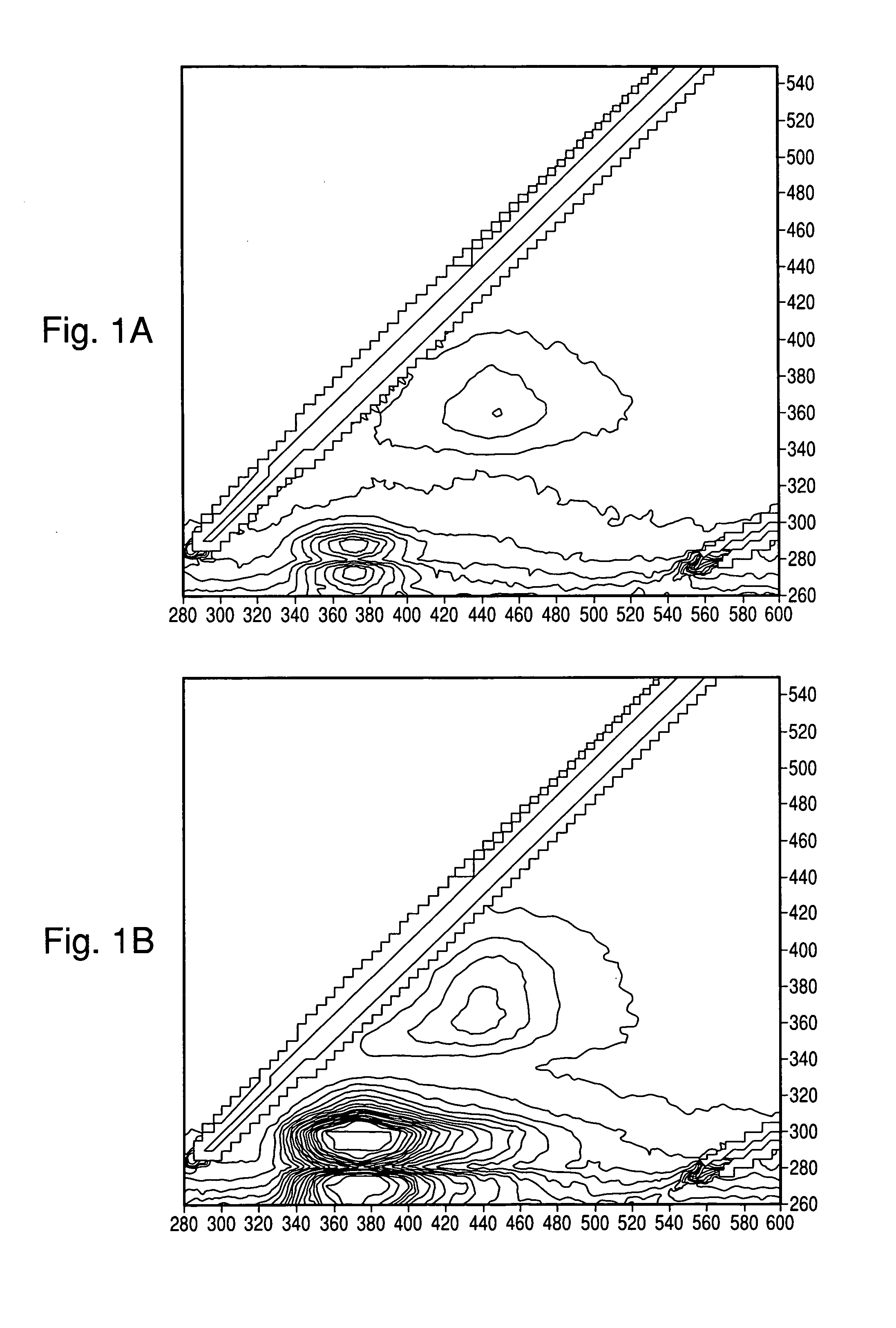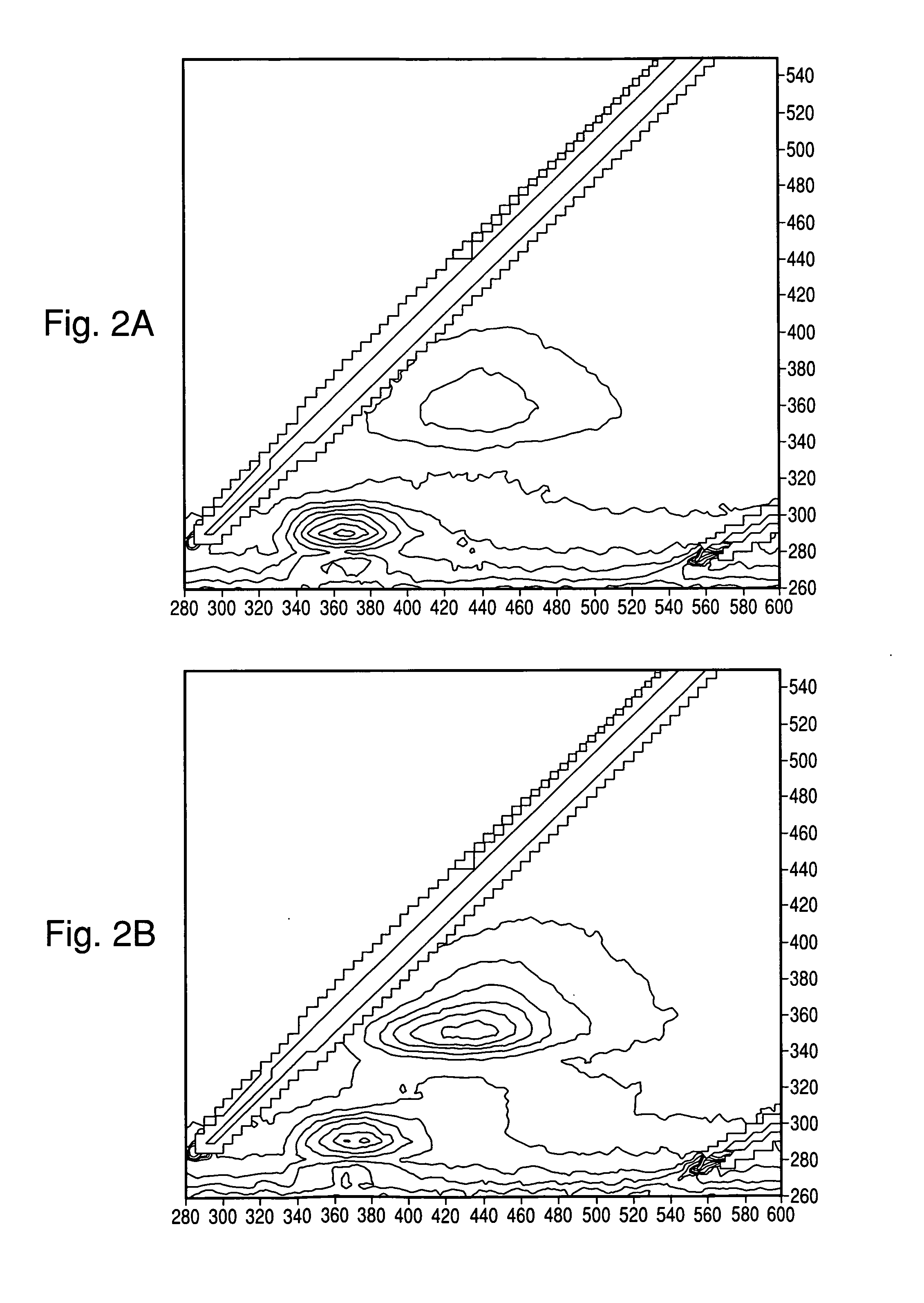Methods for the characterization of microorganisms on solid or semi-solid media
- Summary
- Abstract
- Description
- Claims
- Application Information
AI Technical Summary
Benefits of technology
Problems solved by technology
Method used
Image
Examples
example 1
Obtaining Spectra from Colonies on Plates and Membranes
[0095]Tests were conducted to determine whether useful spectra could be obtained of colonies directly on blood agar plates (BAP; tryptic soy agar with 5% sheep blood), with and without black membranes (Table 1). Colonies of E. coli (EC), S. aureus (SA), E. faecalis (EF), and P. aeruginosa (PA) were grown as indicated in Table 2 and spectra were taken through the UV microscope (10× Objective) coupled with a fiber optic adaptor to a Fluorolog3 spectrometer (Horiba Jobin Yvon, Edison N.J.) and a PMT detector. The EEM was acquired through a wavelength range of Excitation (Ex)=260-550 nm, and Emission (Em)=280-600 nm, every 5 nm with a slit width=5 nm. Where indicated, the interrogation area was narrowed by placing a 1 mm pinhole in the emission path which resulted in an observed area of approximately 0.1 mm. Without the pinhole, the excitation and emission circles as projected on the colonies were equal at approximately 1 mm diamete...
example 2
Scanning for Microcolonies Through the Microscope
[0100]Tests were carried out to determine whether colonies growing under the microscope on a motorized stage could be located by using point-by-point IF measurements, and have IF spectra automatically collected of each colony detected. A UV microscope was coupled to a Fluorolog3 (Horiba Jobin Yvon, Edison N.J.) spectrometer, which served as the fluorescence excitation source and the emission measurement device, via fiber optic cables. The microscope's motorized stage was fitted with a compact plate incubator constructed with coils of tubing fed by a circulating waterbath set to 36° C. The incubator was also equipped with a UV transparent window made from a quartz coverslip. Various agar media were inoculated by spread method with E. coli ATCC 25922 (EC) and / or S. aureus ATCC 25923 (SA) as indicated in Table 3. Some runs used a light blocking material, either a black Whatman Mixed Ester (WME) membrane or charcoal, to reduce the fluores...
example 3
Classification of Microorganism Colonies on Agar Plates
[0112]Tests were carried out to determine whether microbial colonies could be classified from IF spectra taken directly on the agar plate where they were grown.
[0113]The spectral acquisition was done across an excitation (Ex) and emission (Em) matrix of wavelengths 260-580 nm and 260-680 nm, respectively, in a subset of 300 EEM points selected to reduce the acquisition time required. Additionally, all reflectance wavelengths (where Ex=Em) were also read. For fluorescence, the slit widths were set to 5 nm bandpass and the integration time was 1000 ms. Each 300 point acquisition took approximately 8.1 min to complete.
[0114]Table 4 lists the microorganisms tested, which comprised 6 isolates each of 20 species for a total of 120 tests. Where used to indicate groupings other than by species, the term Clinical Gram (ClinGram) refers to the classification level possible by a highly skilled observer reading a Gram stain, not just positi...
PUM
| Property | Measurement | Unit |
|---|---|---|
| Diameter | aaaaa | aaaaa |
| Temperature | aaaaa | aaaaa |
| Temperature | aaaaa | aaaaa |
Abstract
Description
Claims
Application Information
 Login to View More
Login to View More - R&D
- Intellectual Property
- Life Sciences
- Materials
- Tech Scout
- Unparalleled Data Quality
- Higher Quality Content
- 60% Fewer Hallucinations
Browse by: Latest US Patents, China's latest patents, Technical Efficacy Thesaurus, Application Domain, Technology Topic, Popular Technical Reports.
© 2025 PatSnap. All rights reserved.Legal|Privacy policy|Modern Slavery Act Transparency Statement|Sitemap|About US| Contact US: help@patsnap.com



